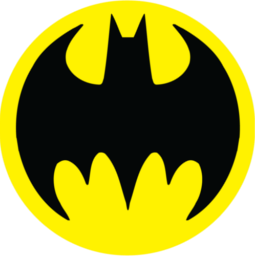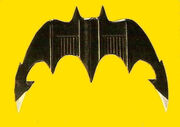| Main Article |
- "Nice outfit."
- ―Jack Napier[src]
The Batsuit was the armor that Batman wore to instill fear into criminals that he would otherwise be unable to do as Bruce Wayne. While it doubled as body armor, that Batsuit had many gadgets and weapons that were hidden within it.
History[]
Batman[]
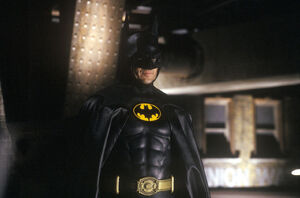
The Batsuit in Batman.
- "Oh...My....God."
- ―James Gordon[src]
The original Batsuit often protected Bruce from the gunfire of common street thugs in the early days. As demonstrated, the suit could easily defend its wearer from multiple point-blank gunshots, although the force of the impact still knocked the wearer off their feet. It was also apparently able to not only protect Batman from physical attacks, but also injured the person who attempted to physically attacked him in the process, as evidenced when Joker attempted to punch Batman after he spit his fake gag teeth out, only for him to react as though he significantly injured his hand afterwards with a distinct snapping sound upon impact.
Other armored points were the gauntlets, which could be used to deflect bullets away from the wearer or to protect the wearer from severe melee strikes and the shin guards seemed to posses similar capabilities. The cape, that was textured to resemble bat wings, could also be unfurled to give the silhouette of a giant bat that completed the "Batman" effect.
The Batsuit was worn by Batman as he battled at Axis Chemicals against the Napier Hoods and used throughout his encounters with the Joker and the Joker Goons, which resulted in various types of toro armor damage and replacements. Bullet holes were visible when they took point blank shots. When not in use, the Batsuit was stored inside a large vault in the Batcave across from Bruce's work station. The entire suit was heavily damaged after Batman crash-landed the Batwing into the steps of the Old Gotham Cathedral.
Batman '89[]

Bruce walks past his various Batsuits.
During a conversation with Alfred about his recent attack by Robin, Bruce walked past his various Batsuits, including the one that he had previously worn in 1989.
Features[]
Utility Belt[]

Batman's Utility Belt
The Utility Belt was built to carry a majority of Batman's crime fighting equipment during missions. It was used to store various tools around the rear side. There are four capsules placed at sides of the torso, containing smoke bombs. The Utility Belt had a motorized track that was used for shifting equipment from the rear of the belt to the front. They usual external items held there were a spring-action reel with various attachments, and a remote control for his armored car.
Plated Gauntlets[]
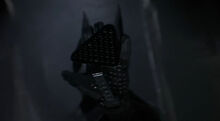
Extendable Gauntlet
The gauntlets on the forearms contained hidden gadgets. The left-hand gauntlet could release a steel extension from his wrist with fast force, knocking at attacker out instantly. It's function is similar to a retractible nightstick. What the right-hand gauntlet may contain within is unknown.
Boots with Shin Guards[]
The boots were also plated at the front , useful items could stored in the sides of the boots such as a Blowgun.
External gadgets associated with this armor[]
Appearances[]
Behind the Scenes[]
Director Tim Burton's desired an all-black Batsuit. The costume was constructed by placing foam latex pieces over a neoprene bodysuit. It was eventually accented with a yellow chest emblem and brass Utility Belt. Heavy armor that was placed on the chest, forearms, and boots replaced the traditional gray spandex and cloth cowl. This became the basic template on which all subsequent live-action Batsuits were based.
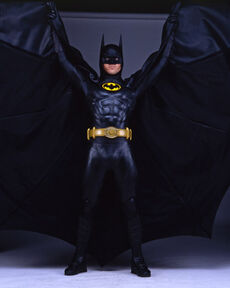
Illustratively designed and overseen by Bob Ringwood, the costume was sculpted by Vin Burnham, essentially inspired by the basic Neal Adams look in terms of silhouette. That Batsuit was notable for its introduction of black eye makeup that was worn under the mask, which was used in every live-action Batman film since, and for the construction of the cowl, which had its scalloped seams glued and bolted down over the cape. This made it nearly impossible for Michael Keaton to turn his head without damaging it. This occurred during the first days of filming in costume, but was later slightly improved amidst principal photography. This costume lacked trunks on the outside of the slacks, which was new at the time. The Batsuit also featured metal plated gauntlets and shin guards which later became commonplace on standard Batsuits.
Trivia[]
- With Tim Burton opting not to use the spandex-look as seen in the comics (due to feeling that the look did not feel intimidating in the live-action film), Bob Ringwood used over 200 comic book issues for inspiration; with 28 foam latex Batsuit designs created, 25 different cape looks, and 6 different cowls, before he settled on the final design that was seen in the film.
- Keaton was not permitted to gain too much weight for the role due to concerns about the costume.[1]
- Due to the restrictions of the suit, Keaton had a tendency make sharp twists with his shoulders to change direction. Blatant attempts to turn the neck too far would leave unflattering gaps in the cheeks, it was typically avoided. This movement has been referred to as "The Bat-Turn" or “The Hero Turn".
- Jon Peters wanted to use Nike product placement on the Batsuit. Batman's Boots in the film ended up being made by using Nike shoes as a base. The boots they shipped to them were an all-black version of Air Trainer IIIs with the Nike "check" logo in bright yellow, which the production team then painted over in black.
- The Grapple Gun that was introduced in the film, was later common place in Batman comic book mythos as the primary tool that Batman used to ascend buildings. The gun was not present in Sam Hamm's Script, which had Batman throwing a grappling hook and attaching the line to a reel in his belt. It was likely conceived sometime after the writer's strike during pre-production. There were a few primitive predecessors to that device that were used in a handful of stories like the Batpoon, first seen in World's Finest #9 or the suction-cup rope guns in Batman #183. None featured the same level of functionality. A full fledged grapple gun wouldn't be used until New Titans #61 in December of 1989. Ironically, DC's Sandman used his Wirepoon gun (likely the first rope gun in popular fiction) since 1941.
- Keaton was reported as feeling a bit claustrophobic in the suit, however, he used the feeling to put himself in a "Batman-like mood". That sentiment was repeated by Christian Bale when he donned his Nomex Batsuit in Batman Begins.
Legacy and Cameo-Appearances[]
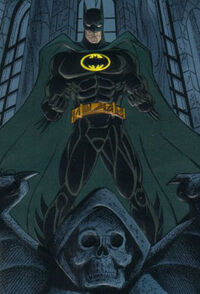
After he recovered from being defeated by Bane, Batman stopped wearing the blue and gray and donned an all-black costume during Troika.
- In the Troika comic book storyline, Bruce donned a Batsuit that had comparisons with the 1989 costume due to its color scheme lack of trunks on the slacks.
- Bruce’s updated 2010 Batsuit, that was first shown in the Batman Incorporated Storyline, was conceptualized by Artist David Finch as an amalgam from the Batsuits in Tim Burton's and Christopher Nolan's Batman Films.
- The visual depiction of the Batsuit in some comic book artistic renditions were sometimes based on the Burton-Batsuit, most notably the cowl.
- The chest emblem was changed to have two points emerging from the bottom center "tail" of the symbol, breaking from tradition. Contrary to popular belief, there is no limit to the amount points on the bottom of the insignia, comic book drawings lack consistency and vary from panel to panel. However the two points emerging sideways from the bottom center is considered unique. Burton wanted to "toughen it up a little" according to his commentary track for the DVD. The chest emblem was made more traditional in Batman Returns, due to fan complaints.
- The concept of the Batsuit being a technological suit of armor, which most notably protected Batman from bullets, continued into future films and later renditions of the Batman film franchise. Some of the best examples include the New 52 Batsuit and the Arkham Knight Batsuit.
